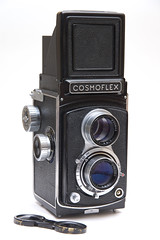Cosmoflex
The Cosmoflex (コスモフレックス) is a Japanese 6×6 TLR of the 1950s, made by Alfa Optical Co. (Arufa Kamera Seisakusho). It is an evolution of the Alfaflex.
Contents
General description
The Cosmoflex is a regular copy of the Rolleicord and is very similar to the Alfaflex. It focuses by moving the entire lens assembly. The focusing and film advance knobs are on the photographer's right, and the focusing knob is surrounded by a depth-of-field scale. There is a magnifying lens in the viewing hood.
All the models have S. Cosmo 7.5cm f/3.5 lenses and a shutter giving B, 1–200 speeds. The release button is placed at the bottom of the front standard (unlike the Alfaflex) and the synch post is buried in the front standard on the opposite side. The TSK and S. Luna shutters mounted on most examples have Kodak style flash synchronization; at least one late example has a different shutter with a PC socket.
The name COSMOFLEX is inscribed on a stepped nameplate above the front plate. Two types of nameplate are known, apparently corresponding to two different body castings. The nameplate with a straight bottom line corresponds to the early body casting, also recognized by the leatherette covering on its front part (outside the moving lens panel); the incurved nameplate corresponds to the late body casting, also recognized by the silver finish of its front part.
Versions
Cosmoflex (I)
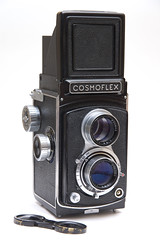
|
| Cosmoflex (I), intermediate, S. Luna shutter with self-timer, black shutter plate. Image by Kenji Gotoh. (Image rights) |
The original Cosmoflex has a sportsfinder in the viewing hood and positions film via red window: the back has a round red window in the middle, protected by a vertically sliding cover. The advance knob contains a film reminder disc. Some examples have an accessory shoe and others don't; its presence or absence seems erratic throughout the production run.
This model was advertised in Japanese photo magazines dated February 1953 until July 1954.[1] In an advertisement dated March 1953,[2] it is offered along with the Alfaflex, and the shutter name and price are not mentioned. In an advertisement by Matsuzaki Shashinki-ten dated May 1953,[3] it is priced at ¥18,000 and the shutter name is spelt "Lunar", certainly by mistake.
The original Cosmoflex is often confused with the cheaper Cosmoflex II.[4]
The early examples have the early type of body casting and have the company name inscribed in small characters on the body, underneath the nameplate, and repeated as ALFA Opt. Co. on the lens rims. The marking on the body merely reads ALFA on at least one example, certainly among the earliest ones.[5] This particular example has no accessory shoe, and a peculiar form of back latch. It is also unusual in having a TSK shutter with a self-timer. The silver shutter plate points towards the top and has a red TSK logo. This shutter was surely made by Tōyō Seiki Kōgaku.
The marking under the nameplate reads ALFA OPTICAL CO. on other examples. These have an S. Luna shutter with no self-timer, probably a successor of the TSK made by the same company Tōyō Seiki Kōgaku.[6] The silver shutter plate points towards the left (as seen from the front) and the aperture scale is on the right.
The intermediate examples have the straight nameplate and no apparent company name, and have an S. Luna shutter. It seems that the company name simultaneously disappeared from the body and lens rims. Soon after, the shutter received a self-timer and was mounted in a slanted position: the silver shutter plate now points towards the top left, and the aperture scale is to the bottom.[7] This silver shutter plate was replaced by a black one, with the same design but inverted colours.[8]
The late examples have the newer body casting and incurved nameplate. They are only known with the self-timer equipped S. Luna and the newer black shutter plate.[9]
Cosmoflex II
The Cosmoflex II was released as a cheaper model, direct replacement of the Alfaflex. It has no sportsfinder, no film reminder and no accessory shoe, and still has red window film advance. The back latch slightly differs from that of the other versions.
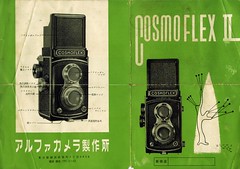
|
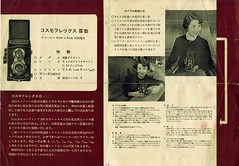
|
| User manual for the Cosmoflex II (in Japanese). Scans by Kenji Gotoh. (Image rights) | |
The regular Cosmoflex II have the company name inscribed as ALFA OPTICAL CO. under the nameplate and as ALFA Opt. Co. on the lens rims. Surviving examples are known with a TSK shutter, marked TSK on the speed rim and TOYO S.K.CO on a black shutter plate pointing to the left, with no self-timer.[10] In the user manual, the shutter is called "T.S.K. Luna" and the picture shows the S. LUNA engraving and the silver shutter plate pointing to the left, same as on some Cosmoflex (I).
The Cosmoflex II was advertised in Japanese photo magazines dated from February until December 1954.[11] The February advertisement in Asahi Camera gives the price of ¥13,800.[12] The picture shows a camera with the incurved nameplate and newer body casting, indicating that it was already introduced by that date. No other example of the Cosmoflex II is known with the newer body.
Cosmoflex III
The Cosmoflex III is based on the original Cosmoflex (I) but has semi-automatic film advance, unlocked by pressing the center part of the advance knob. There is a round window for an exposure counter at the top of the right-hand side plate, and a sliding button next to the advance knob to engage the exposure counter mechanism. The lenses are the same S. Cosmo as on the previous models. The shutter has B, 1–200 speeds, a self-timer and internal synchronization. There is an accessory shoe on the photographer's left.
This model was advertised in Japanese photo magazines dated from February until December of 1954.[13] In the advertisement dated February cited above,[14] it is announced as "available soon" (近日発売) and no price is indicated. The camera pictured as a Cosmoflex III does not have the exposure counter window and is actually an intermediate Cosmoflex (I), with a self-timer and a silver shutter plate.

|
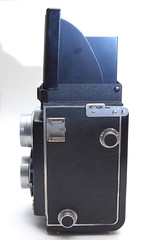
|
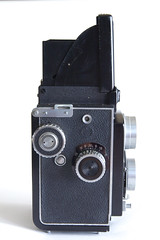
|
| Cosmoflex III, S. Luna shutter, S. Cosmo lenses no.50062 (taking) and 50551 (viewing). Image by Kenji Gotoh. (Image rights) | ||
The Cosmoflex III pictured in this article has the early nameplate and body casting, and does not have any company name engraving. It has the S. Luna shutter, with the black shutter plate and a self-timer. The only other example observed so far is pictured in a JCII exhibition catalogue; it has a CHY-SB shutter and a PC synch socket.[15] The shutter itself is externally indistinguishable from the S. Luna but for the CHY–SB engraving on the speed rim; it has the same control layout and the same black shutter plate, and might be a renamed successor of the S. Luna.
Geared-lens model
A completely different Cosmoflex has been observed, looking like a copy of the Ricohflex III with externally geared lenses.[16] The taking lens has a focusing tab. The advance knob is on the photographer's right and contains a film reminder dial. There is a rectangular red window near the bottom of the back, protected by a vertically sliding cover. The viewing hood contains a magnifying lens and a sportsfinder. The nameplate reads COSMOFLEX and is attached by two apparent screws. There is a decorative metal frame around the lenses, as on the Amiflex, whose body is extremely similar.
The lenses are S. Cosmo f/3.5, with the late type of engraving. The shutter has 1/200 top speed and is perhaps engraved COSMO on the speed rim. The release lever is mounted on the metal frame and the PC synch post is directly placed on the shutter casing.
Notes
- ↑ Kokusan kamera no rekishi, p.351.
- ↑ Advertisement published in Shashin Salon, reproduced in Kokusan kamera no rekishi, p.117.
- ↑ Advertisement published in Shashin Salon, reproduced in Kokusan kamera no rekishi, p.117.
- ↑ This confusion is notably made in Sugiyama, items 2077–8, McKeown, p.44, and here at Aya's Camera.
- ↑ Example observed in an online auction (taking lens no.17501, viewing lens no.17611).
- ↑ With no shoe: examples pictured in McKeown, p.44, and in this page at Aya's Camera (where they are misidentified as "Cosmoflex II"). With a shoe: example pictured in Sugiyama, item 2078 (again misidentified as a "Cosmoflex II").
- ↑ No self-timer, silver plate: example pictured in this page at tlr-cameras.com (with a shoe). Self-timer, silver plate: examples observed in online auctions (with and without a shoe).
- ↑ Self-timer, black plate: example observed in this article (with no shoe).
- ↑ Examples observed in online auctions. The example pictured in this page at Otowa no nigan-refu perhaps corresponds to a late Cosmoflex (I) too.
- ↑ Example pictured in Sugiyama, item 2077 (misidentified as a "Cosmoflex I"), and example pictured here at Japan Family Camera (archived).
- ↑ Kokusan kamera no rekishi, p.351.
- ↑ Advertisement published in Asahi Camera, reproduced in Kokusan kamera no rekishi, p.136. The exact same advertisement is reproduced here at Shashin-Bako.
- ↑ Kokusan kamera no rekishi, p.351.
- ↑ Advertisement published in Asahi Camera, reproduced in Kokusan kamera no rekishi, p.136. The exact same advertisement is reproduced here at Shashin-Bako.
- ↑ Example pictured in Watakushi no ni-gan-refu kamera-ten, p.27.
- ↑ Example observed in an online auction.
Sources / further reading
- Alfa Camera Seisakusho (アルファカメラ製作所). User manual of the Cosmoflex II. Reproduced in this Flickr album by Juangotoh.
- Asahi Camera (アサヒカメラ) editorial staff. Shōwa 10–40nen kōkoku ni miru kokusan kamera no rekishi (昭和10–40年広告にみる国産カメラの歴史, Japanese camera history as seen in advertisements, 1935–1965). Tokyo: Asahi Shinbunsha, 1994. ISBN 4-02-330312-7. Items 508–10. (See also the advertisement for item 374.)
- Lewis, Gordon, ed. The History of the Japanese Camera. Rochester, N.Y.: George Eastman House, International Museum of Photography & Film, 1991. ISBN 0-935398-17-1 (paper), 0-935398-16-3 (hard). Pp.80, 82, 88 (brief mentions only).
- McKeown, James M. and Joan C. McKeown's Price Guide to Antique and Classic Cameras, 12th Edition, 2005-2006. USA, Centennial Photo Service, 2004. ISBN 0-931838-40-1 (hardcover). ISBN 0-931838-41-X (softcover). P.44.
- Sugiyama, Kōichi (杉山浩一); Naoi, Hiroaki (直井浩明); Bullock, John R. The Collector's Guide to Japanese Cameras. 国産カメラ図鑑 (Kokusan kamera zukan). Tokyo: Asahi Sonorama, 1985. ISBN 4-257-03187-5. Items 2077–8.
- Watakushi no ni-gan-refu kamera-ten (私の二眼レフカメラ展, Exhibition of twin lens reflex cameras). Tokyo: JCII Camera Museum, 1992. (Exhibition catalogue, no ISBN number.) P.27.
Links
In English:
- Japanese TLR page (with the Cosmoflex) in Barry Toogood's tlr-cameras.com
In Japanese:
- Cosmoflex (misidentified as a Cosmoflex II) at Aya's Camera, with black & white and colour samples
- Cosmoflex at Otowa no nigan-refu
- Cosmoflex II (archived) at Japan Family Camera, with repair notes for the TSK shutter
- Advertisement for the Cosmoflex dated 1954, reproduced in Shashin-Bako
